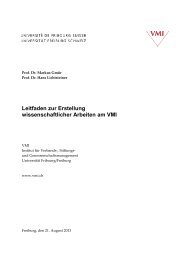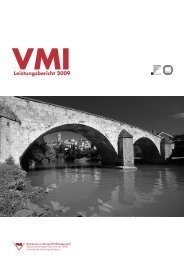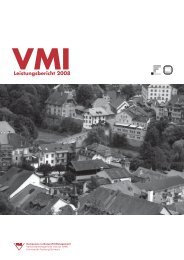Government Policy and the Nonprofit Sector: Switzerland - VMI
Government Policy and the Nonprofit Sector: Switzerland - VMI
Government Policy and the Nonprofit Sector: Switzerland - VMI
- TAGS
- nonprofit
- switzerland
- vmi.ch
You also want an ePaper? Increase the reach of your titles
YUMPU automatically turns print PDFs into web optimized ePapers that Google loves.
Nollert <strong>and</strong> Budowski <strong>Government</strong> <strong>Policy</strong> <strong>and</strong> <strong>the</strong> <strong>Nonprofit</strong> <strong>Sector</strong>: Switzerl<strong>and</strong><br />
Federal Office of Sports 21 <strong>and</strong> sport associations, or contracts by <strong>the</strong> Federal Agency for Development <strong>and</strong><br />
Cooperation (SDC) 22 for missions abroad <strong>and</strong> international assignments. A good example of <strong>the</strong> willingness of<br />
<strong>the</strong> state to support NPOs by injection of capital is <strong>the</strong> NPO‐certifying foundation ZEWO (see section III.b); its<br />
start‐up capital was largely provided by <strong>the</strong> cantons.<br />
Ano<strong>the</strong>r source of state support is <strong>the</strong> subsidizing of voluntary work by contributing funds to NPOs for<br />
investment in recruitment, initial training <strong>and</strong> fur<strong>the</strong>r education, <strong>and</strong> providing partial compensation for<br />
volunteers. These subsidies are, however, rare <strong>and</strong> concentrate mainly on providing funds to finance training<br />
programs for leaders of Youth <strong>and</strong> Sports associations 23 <strong>and</strong> for sports for <strong>the</strong> elderly.<br />
The state’s positive stance on NPOs was apparent in its tacit (symbolic) support of <strong>the</strong> commission of a report on<br />
voluntary work in Switzerl<strong>and</strong> in 2004. The report was financed <strong>and</strong> coordinated by an office subsidiary to <strong>the</strong><br />
Swiss Federal <strong>Government</strong>: <strong>the</strong> Swiss Federal Statistical Office 24 . It provides a summary of volunteer work <strong>and</strong><br />
includes a list of measures designed to promote volunteer work. The foreword of <strong>the</strong> report mentions that no<br />
new measures are presently to be expected as a result of state financial constraints.<br />
2. Extent of <strong>Government</strong>al Support<br />
The increased recognition <strong>and</strong> importance of service agreements over <strong>the</strong> past few years has highlighted <strong>the</strong><br />
relationship of support between <strong>the</strong> state <strong>and</strong> NPOs. Contracts between <strong>the</strong> government, cantons or<br />
municipalities <strong>and</strong> NPOs (or indeed commercial organizations) consist of <strong>the</strong> organization’s commitment to<br />
provide a public service remunerated by <strong>the</strong> public purse. A fur<strong>the</strong>r form of such mutual support is <strong>the</strong> public‐<br />
private partnership. This form of collaboration differs from a service agreement in that <strong>the</strong> exchange of services<br />
is not contractual.<br />
Until <strong>the</strong> 1990s <strong>the</strong> lack of data precluded a precise estimate of <strong>the</strong> level of monetary contribution assigned to<br />
<strong>the</strong>se service agreements. In order to provide such evidence <strong>the</strong> first Subsidy Report was published in 1997<br />
allowing for <strong>the</strong> conclusion that <strong>the</strong> Swiss State is actually a transfer state regarding subsidies. This conclusion is<br />
supported by <strong>the</strong> Swiss Statistics for Subsidies 25 that confirms <strong>the</strong> allocation of considerable sums to such<br />
service agreements <strong>and</strong> that such subsidies account for more than half of <strong>the</strong> Federal budget.<br />
According to <strong>the</strong> 1997 Subsidy Report 26 (EFD 1997), social welfare, transport, agriculture, <strong>and</strong> nutrition each<br />
account for more than 10 percent of <strong>the</strong> subsidies in <strong>the</strong>ir fields <strong>and</strong> are <strong>the</strong>refore <strong>the</strong> largest beneficiaries. If<br />
<strong>the</strong> development of <strong>the</strong>se various sectors is extrapolated over <strong>the</strong> period 1970‐1997, social welfare, an area<br />
where many NPOs are actively involved, may be receiving more than 50 percent (15 billion CHF) of all subsidies.<br />
However, it is worth noting that in 1997, 85 percent of all subsidies went to federally‐owned institutions (e.g.<br />
social insurances, railways, national roads) <strong>and</strong> only 8.2 percent to private organizations (6.8 percent went to<br />
21<br />
Bundesamt für Sport (BASPO)<br />
22<br />
Direktion für Entwicklung und Zusammenarbeit (DEZA)<br />
23<br />
Jugend und Sport<br />
24<br />
Bundesamt für Statistik<br />
25<br />
Schweizerische Subventionsstatistik<br />
26<br />
Subventionsbericht<br />
7











